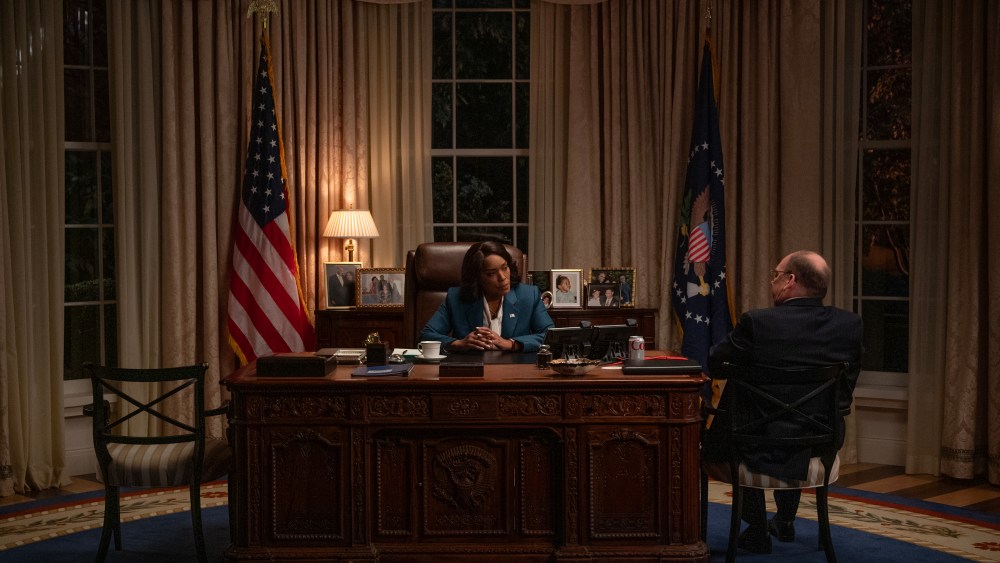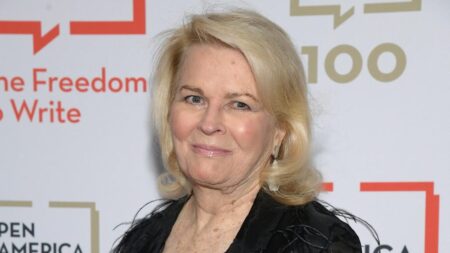Over the years, the White House has long been a staple set as shows have explored looks into the machinations of America’s highest office.
This season, “The Residence,” “Zero Day” and “Paradise” are among those series taking audiences into the hallways and bedrooms of 1600 Pennsylvania Ave.
With TV and film crews are prohibited from shooting at the real location, it was left to production designers to replicate the historic residence through their work, more often than not, by using
previously built sets.
Netflix’s political thriller “Zero Day” stars Robert De Niro as a former president forced out of retirement t investigate a deadly “zero-day” cyberattack. Production designer Anastasia White could take creative liberty with her design because they “weren’t re-creating a former president’s space,” but rather that of a fictional commander-in-chief.
The Oval Office was her most elaborate build for what was only a few pages of the script. “We ended up renting an Oval Office [set] and modifying and adding to it,” says White. But, she was no stranger to the stage set because she had previously used it on the Max series “White House Plumbers.” When she got the flats, they were in rough shape but at least provided a foundation for her team to work with. “We had to rebuild a lot of the molding and doors.”
Angela Bassett plays the current president, Evelyn Mitchell, in “Zero Day,” leaving open the question of how the décor had changed, if at all, between the two administrations. “We didn’t really have a reference,” says White. “But there seems to be the same language as far as paintings, style and the tone of furniture, so we knew we had to keep it traditional in that way.”
However, she did make some modifications, adding more color to the famous office without straying too far from reality.
On Dan Fogelman’s political thriller “Paradise,” production designer Kevin Bird had six weeks to create a space that was fitting for James Marsden’s president. Bird says, “He’s a youthful president, and we embraced that.”
Renderings from Kevin Bird’s White House for ‘Paradise’
The series has a dystopian twist and is set in an underground world in the mountains of Colorado
after a global catastrophe occurs.
Bird knew the show was going to be shot in Los Angeles, which meant the Oval Office and the Rose Garden existed in various forms. “You’re getting old flats that have been used in movies, but you’re starting from scratch. It’s like the plasterers and the carpenters have to repair everything,” says Bird. “It’s at 95% scale, so it’s almost exactly the size of the real one.”
Bird’s team wanted to lean into the white walls of the Oval Office. “I knew there would be a lot of
scenes with guys in suits, so I wanted that to really pop against the white,” he explains. “I figured we should just embrace that.”

The Oval Office on ‘Paradise’
He worked closely with the show’s cinematographer, Yasu Tanida. “We try to avoid white on TV, but I spoke with Yasu early on about how to make it work. How do we embrace this white world? And that set the tone for the blues and whites.”
That could then contrast against the town of Paradise and the fake underground city, which was warmly lit.

Concepts for ‘Paradise’
Production designer François Audouy wanted to show audiences a White House they had never seen before, and brought that into “The Residence,” a whodunnit with Uzo Aduba as detective Cordelia Cupp attempting to narrow down her list of suspects.
But Audouy didn’t use existing sets. The show, which opens with a tour through the White House and ends with a board-game-esque view, was shot at Raleigh Studios in Los Angeles, which served as his home base where he built his sets.
Audouy was inspired by Jerry Lewis’ 1961 film “The Ladies Man.” “They built a three-story house at Paramount and used a crane just for the camera to pull out and see the three floors,” Audouy says. “There was no way we were going to be able to build four stories stacked on top of each other. We took over seven stages, and we built a floor per stage.” Those rooms were then digitally composited together to fit. “When the camera moves through the spaces and they’re glued together digitally, it gives the effect that it’s all a contiguous space, even though it’s not.”
Since the story revolved around a fictional presidency, Audouy was able to heighten the colors and stylize the spaces to create a “seductive aesthetic.”
The biggest set was the show’s State Floor at 21,000 square feet and required two conjoining soundstages: “It turned out to be a showstopper.”
The White House State Floor has rooms designated by color (green, blue and red), and has state dining rooms and other offices. Audouy built fireplaces in every room, and each one had custom drapery with wallpaper from Italy. “We were very much inspired by the real White House State Floor, but our story gave us the opportunity to push it a little bit.”
Audouy used a shade called Cardinal Red for the Red Room. For the Blue Room, which in reality is beige with blue accents, Audouy looked to past photographs and was more inspired by the room when it had been designed by Maison Jansen under the Kennedy administration.
“It’s all about refining what the audience thinks they know about the State Floor and pushing it to
be more stylized,” he says.
Similarly, for the executive mansion, he imagined “what a floor that had been designed for this fictitious president would look like. I did my own thing up there, with the exception of the yellow oval room, which was our own version of something luxurious, rich and chic.”
Elsewhere, he created his version of the Treaty Room and central hallway, then re-created the Lincoln bedroom and the Queen’s bedroom, very much as they are. The key was to make sure each space was its own character.
Since there are hardly any photos available of the basement, Audouy could take creative liberty with the space where the executive chef, butlers and electricians reside.
“It was fun to imagine it as a labyrinth with low ceilings and rusty pipes,” he says. “It really creates this upstairs-downstairs feeling.”

Renderings for ‘The Residence’
Read the full article here








